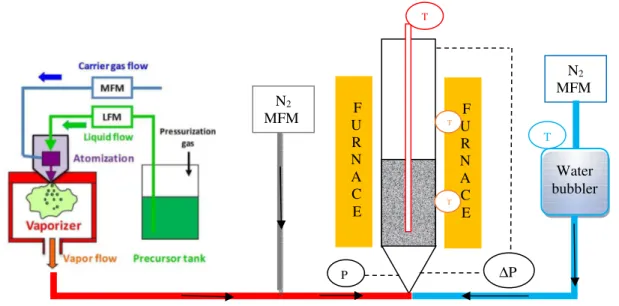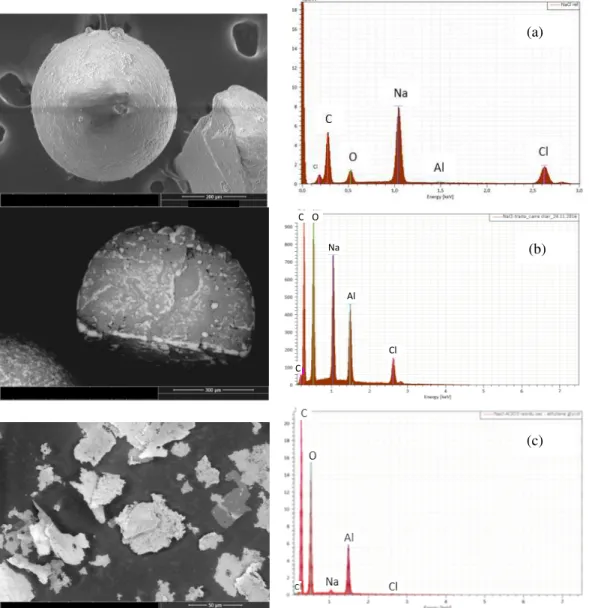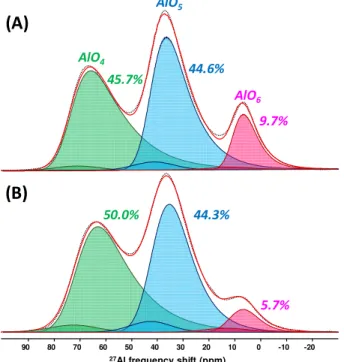OATAO is an open access repository that collects the work of Toulouse
researchers and makes it freely available over the web where possible
Any correspondence concerning this service should be sent
to the repository administrator:
tech-oatao@listes-diff.inp-toulouse.fr
This is an author’s version published in: http://oatao.univ-toulouse.fr/21799
To cite this version:
Caussat, Brigitte
and Samélor, Diane
and Gleizes, Alain
and Sarou-Kanian, Vincent
and Florian, Pierre and Vahlas, Constantin
Fluidized Bed CVD of [5]Al-rich amorphous
alumina on powders for catalysis applications. In: STP 2018, 3 July 2018 - 5 July 2018
(Compiègne, France).
Fluidized Bed CVD of
[5]Al-rich amorphous alumina on powders
for catalysis applications
B. Caussat1*, D. Samelor2, A.N. Gleizes2, V. Sarou-Kanian3, P. Florian3, C. Vahlas2
1 Laboratoire de Génie Chimique, Université de Toulouse, CNRS, Toulouse, France. 2 CIRIMAT, Université de Toulouse, CNRS, Toulouse, France.
3 CEMHTI, Université d’Orléans, CNRS, Orléans, France. *brigitte.caussat@ensiacet.fr
Keywords : Fluidized bed, CVD, alumina, DMAI, aluminum coordination, catalysis.
Abstract :
Producing alumina catalysts containing high amounts of penta-coordinated aluminum sites ([5]Al) is of
main interest to develop a green production of olefins from biomass. Inspired from an original process developed on planar substrates at low pressure, a Fluidized Bed Chemical Vapor Deposition (CVD) process coupled to a DLI (Direct Liquid Injection) system has been studied at atmospheric pressure to deposit amorphous alumina on soluble NaCl powders, using dimethyl aluminum isopropoxide (DMAI) as precursor. A set of experiments has been performed at 310°C, showing the good reproducibility of the deposition process in terms of deposit morphology, mass and chemical composition. Nuclear Magnetic Resonance of aluminum-27 probing the structure at atomic scale of the deposit indicates the presence of high contents of penta-coordinated aluminum, as it was the case on planar substrates. This demonstrates that this DLI-CVD route from DMAI is robust. Coupled with a fluidized bed, it could lead to massive production of high specific surface area amorphous alumina with high content of penta-coordinated aluminum environments.
1. Introduction
Since roughly ten years, the worldwide demand for olefins, in particular ethylene, is expanding. As olefins mainly depend on fossil resources, their production is limited by the finite reserves. Research on alternative technologies for their selective fabrication is then imperative [1]. Ethanol derived from biomass, i.e. cellulose, corn, and sugarcane, is the most common bio-feedstock for the production of ethylene [2]. Ethanol dehydration necessitates high performance catalysts. A challenge for the next years then concerns the development of such catalysts.
Alumina based catalysts are very promising, since they exhibit high conversion and selectivity values during ethanol dehydration reaction [3]. Many attempts have been made to understand the nature of alumina surfaces, especially the various Brønsted and Lewis acid sites which are considered as active centers in acid-catalyzed reactions [3]. It is generally accepted that the primary acid sites are the Lewis ones, which are the active centers in alcohol dehydration reaction [4]. However, which kind of aluminum site, i.e. four-, five-, or six-coordinated aluminum environment, is responsible for the catalysis is still an open question. Recent results provide good evidence that the penta-coordinated aluminum sites ([5]Al) are the catalytic active sites on transitional and alpha alumina surfaces during
ethanol dehydration reaction [3].
An original Chemical Vapor Deposition (CVD) process coupled to a DLI (Direct Liquid Injection) system using dimethyl aluminum isopropoxide (DMAI) as precursor has been developed at low pressure (5 Torr) on planar substrates, succeeding in forming amorphous alumina thin films with high contents of [5]Al sites [5].
The present communication details the transposition of this process to NaCl soluble powders, in order to produce catalysts of higher specific surface area in comparison with planar substrates. This has been done using a Fluidized Bed CVD process coupled with a DLI setup from DMAI at atmospheric pressure.
2. Experimental
The experimental setup (Figure 1) consists in a vertical stainless steel Fluidized Bed CVD reactor (internal diameter of 5 cm and 1 m in height) heated by a two-zone external furnace. At the bottom, a perforated steel plate provides a homogeneous gas distribution. A high performance HEPA13 filtration cartridge is mounted before the exhaust of the reactor to collect any elutriated particle. DMAI (Air Liquide) was used as precursor, dissolved in cyclohexane (99.5 % extra dry, Acros Organics). The solution was atomized and then totally vaporized at 100°C in a Kemstream Vapbox 500® DLI
equipment, in which the nitrogen (N50, Air Liquide) carrier gas flow was fixed at 1 slm. This injection system offers several advantages over classical sublimation and evaporation technics since it provides constant precursor vapor flow and leads to a more stable, robust and reproducible process [5]. Water vapor was added as an oxidant using a bubbler maintained at 1°C, in which a nitrogen flow was fixed at 0. 4 slm. An additional N2 flow was organized in order to reach a fluidization ratio close to 2 at the
reactor inlet. Gas flows were controlled by mass flow meters (MFM FC-7700 type; Aera). A differential pressure sensor (Unik5000; Druck Ltd.) measured the total pressure drop across the bed. An absolute pressure sensor (PR21; Keller) allowed monitoring the total pressure below the distributor. Three K-type thermocouples were fixed in a small tube along the vertical axis of the reactor to measure the bed temperatures, two on the outer reactor walls to control the furnace and one into the water bubbler.
Figure 1: Schematic representation of the DLI Fluidized Bed CVD setup
NaCl powders (Alfa Aesar) of 456 microns of median diameter were used, in order to dissolve the support after alumina deposition for NMR analyses. Their minimum fluidization velocity at 20°C is 10 cm/s. 230 g of powders were used per run, corresponding to a fixed bed height on column diameter ratio of 2. Five experiments were performed for which the deposit duration was varied between 70 and 245 min, to analyze the deposition process stability. Dissolution of NaCl powders after deposition was performed using ethylene glycol.
The morphology of the powders was analyzed before and after deposition by Scanning Electron Microscopy on a FEI Quanta 450 associated to an Energy Dispersive X-Ray (EDX) detector (Bruker Quantax, SDD) to have information on their chemical composition. ICP-AES
allowed to measure the amount of deposited aluminum. Solid-state 27Al NMR experiments were
carried out on a Bruker AVANCE III spectrometer operating at a magnetic field of 20.0 T (corresponding to 27Al frequency of 221.5 MHz) with a 2.5 mm MAS probe head. The 27Al one–
dimensional (1D) MAS spectrum was recorded with a spinning frequency of 33.333 kHz, and with an excitation pulse length of 0.37 µs, i.e. a flip angle less than π/18 to ensure a quantitative 1D spectrum (radio–frequency field νRF = 75 kHz). The recycle delay was 20 ms and the number of transients was
32268. The spectrum was referenced with respect to a 1 M solution of Al(NO3)3. Quantification was
performed using the Dmfit software [6].
Water bubbler N2 MFM N2 MFM F U R N A C E ∆P P T F U R N A C E T T T
3. Results and discussion
First, the deposition rate was reproducible, close to 10 mg/min, leading to deposited weights not exceeding 2.5 g, as measured by ICP-AES. As a consequence of this low deposited weight, no influence of the deposit appeared on the bed pressure drop and thermal profile. By following in real time the bed pressure drop, the bed of powders remained fluidized during all deposition experiments. The bed thermal profile was close to the target bed temperature of 310°C, with an axial gradient not exceeding 6°C.
Numerous SEM and SEM-EDX analyses have been performed showing that the deposit morphology and chemical composition are reproducible and uniform on the whole powders of the bed. Characteristic examples of results are given in Figure 2. The raw NaCl powders present a quite smooth and faceted morphology with small level of C and O contamination from ambient air. After deposition, the alumina deposit form discontinuous nodules of several tens of microns and also appears as diffuse irregular films on the NaCl powders. Faceted zones seem to be more coated. This morphology could reveal nucleation difficulty on such surface. The EDX analyses confirm the presence of Al and O atoms on the powders, the Na and Cl species being still present. After NaCl dissolution, the alumina dry residue forms porous lamellas of several tens of microns. The EDX Na and Cl peaks have strongly decreased, showing the efficiency of the NaCl dissolution, probably due to the discontinuous nature of the alumina deposit.
Figure 2: SEM view and EDX analysis of (a) the raw NaCl powders, (b) the deposit on the NaCl powders and (c) the deposit after NaCl dissolution (Al2O3 dry residue)
Cl Al Na O C C (a) (b) (c)
The local structure of the amorphous Al2O3 thin films using very high magnetic field solid-state 27Al
MAS NMR (20 T) allows identifying and quantifying the polyhedral aluminum coordination in terms of proportions (at.%) and degree of local disorder (polyhedron distortions). Figure 3 shows
experimental and reconstructed 27Al MAS NMR spectra of alumina films prepared from DLI-DMAI in
different experimental conditions (Fluidized Bed at atmospheric pressure and planar substrate at 5 Torr). The one dimensional 27Al MAS NMR spectrum consists of 3 overlapping broad lines, each of
them corresponding to AlO4, AlO5 and AlO6 coordination units which are characteristic of amorphous
alumina-containing materials [7]. The spectrum quantification shows high content of AlO5 (ca.
44 at.%) for the film processed with the Fluidized Bed set up, and is really similar to what we obtained for a film processed on planar substrate. It can be noticed that the proportion of AlO6 increases
(5.7→9.7 at.%) at the detrimental of AlO4 (50.0→45.7 at.%) for the FB CVD route. This could be due
to the presence of hydroxyl groups in the amorphous structure which promotes the formation of AlO6
units [8], probably formed during the NaCl dissolution process, which remains to be optimized.
27Al frequency shift (ppm) -20 -10 0 10 20 30 40 50 60 70 80 90 45.7% 44.6% 9.7% 50.0% 44.3% 5.7% AlO4 AlO5 AlO6
(A)
(B)
Figure 3: 1D quantitative 27Al solid-state NMR spectra for the amorphous alumina films processed (A) by Fluidized Bed CVD at atmospheric pressure and (B) by CVD on planar substrates at 5 Torr. Fitting of the NMR
spectra was performed using the “Czjzek model” (Gaussian isotropic model). Proportions are given in at.% 4. Conclusions
The results demonstrate that the DLI-CVD process from DMAI is robust and when coupled with a Fluidized Bed, it has the potential to mass produce high specific surface area [5]Al rich amorphous
alumina. Catalytic tests are in progress for ethanol dehydration.
References
1. Zacharopoulou V., Lemonidou A.A., 2018, Catalysts, 8, 2.
2. Mohsenzadeh A., Zamani A., Taherzadeh M.J., 2017, ChemBioEng Rev., 4, 75.
3. Hu J.Z., Xu S., Kwak J.H., Hu M.Y., Wan C., Zhao Z., Szanyi J., Bao X., Han X., Wang Y., Peden C.H.F., 2016, J. Catalysis, 336, 85.
4. De Wilde J.F., Chiang H., Hickman D.A., Ho C.R., Bhan A., 2013, ACS Catal. 3, 798.
5. Baggetto L., Charvillat C., Esvan J., Thebault Y., Samelor D., Vergnes H., Caussat B., Gleizes A., Vahlas C., 2015, CVD, Advanced Materials, 21, 343.
6. Massiot D., Fayon F., Capron M., King I., Calvé S. L., Alonso B., Durand J. O., Bujoli B., Gan Z. and Hoatson G., Magn. Reson. Chem., 2002, 40, 70-76.
7. Kim N., Bassiri R., Fejer M. M. and Stebbins J. F., Journal of Non-Crystalline Solids, 2014, 405, 1-6. 8. Baggetto L., Sarou-Kanian V., Florian P. Gleizes A.N., Massiot D., Vahlas C., PCCP, 2017, 19, 8101-8110.


